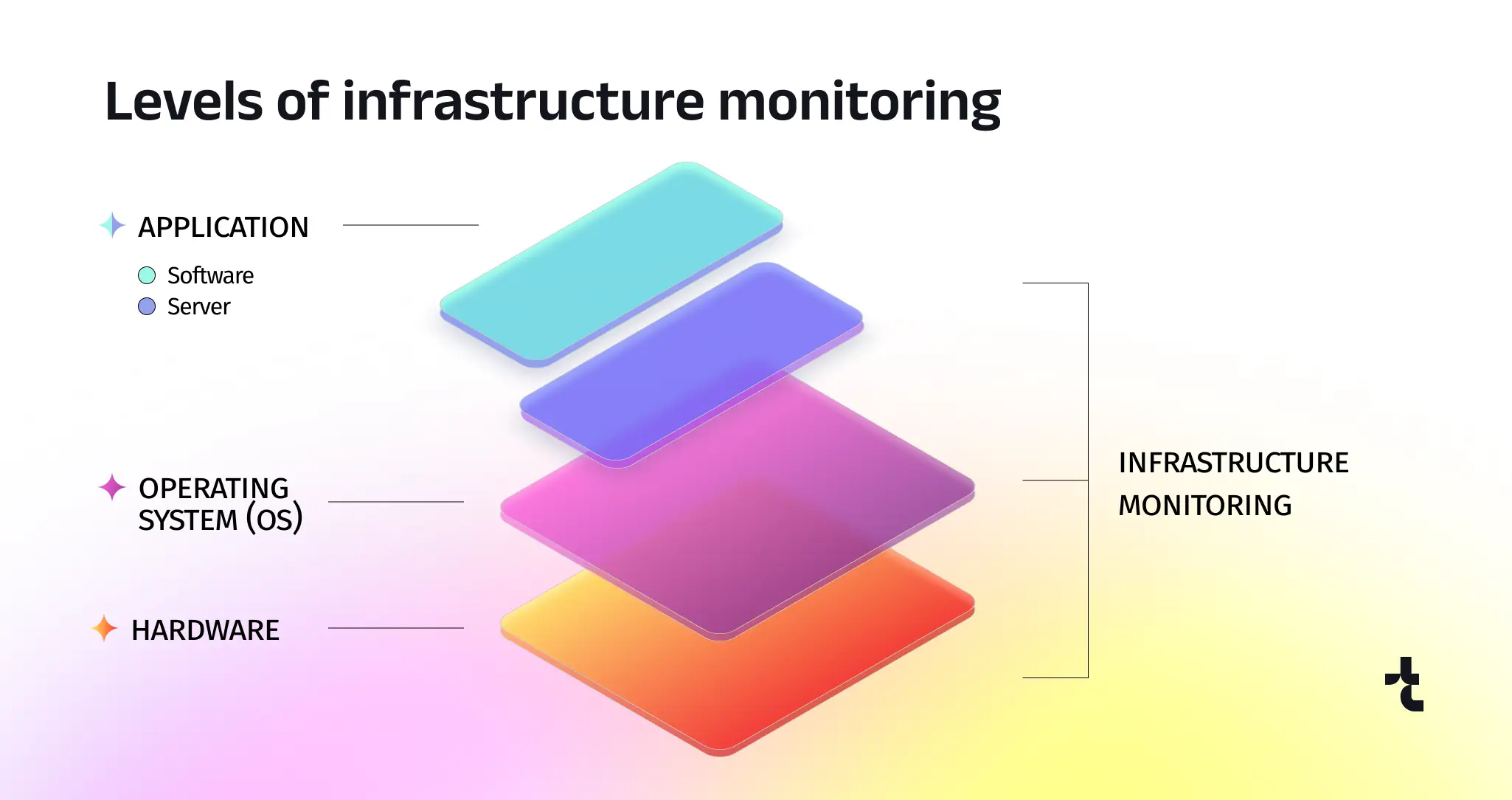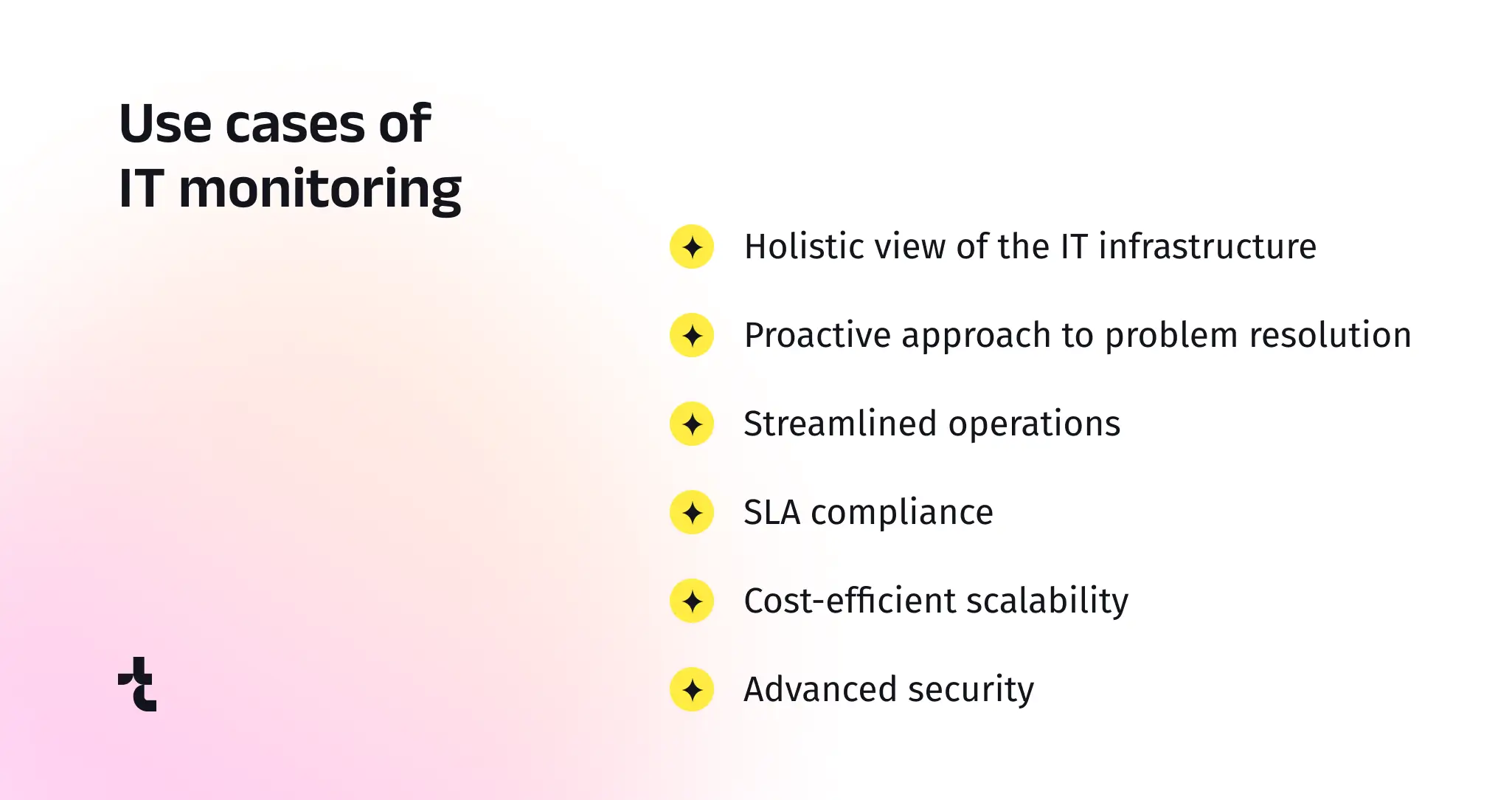Infrastructure Monitoring Tools Explained: Tools, Benefits, and Best Practices
Anna Rozhentsova, Content Writer
December 9, 2024
The digital transformation brought applications and IT platforms to the forefront, changing the way businesses optimize their operations. Yet, even with these advancements, there is still a need to track operations for reliability and good performance. Whether your services are provided in the cloud, on-premises, or in a hybrid environment, as a web solution or native application, infrastructure monitoring is your go-to solution for ensuring everything runs like clockwork.
In this article, we’ll explore infrastructure monitoring tools’ benefits and use cases, what can be monitored, and key factors to consider when integrating them.
How IT monitoring tools can help you win
Simply put, infrastructure monitoring is the process of collecting and analyzing data on the performance of the backend components – the company’s infrastructure, servers, networks, virtual machines, containers, and databases. It aims to optimize the processes and operations on multiple layers of the tech stack, making them efficient and reliable for both the business and the end-users.
Infrastructure monitoring tools serve as guardians for overseeing IT operations and maintaining their efficiency. With over two-thirds of all outages costing more than $100,000, implementing monitoring solutions is a wise choice for organizations wishing to address potential issues proactively before performance hurdles or application downtime can escalate into critical incidents and revenue loss.
Goals and use cases of infrastructure monitoring
Infrastructure monitoring provides solutions to a variety of tasks, from minimizing downtime to optimizing resource management, all of which have a direct impact on your business’s success.
Here are the most popular tasks and use cases of infrastructure monitoring solutions.
Holistic view of the IT infrastructure
By integrating infrastructure monitoring tools, businesses gain a comprehensive understanding of their entire IT ecosystem, from servers and networks to applications and databases. A thorough monitoring solution will provide insight into the underlying cause of an issue—whether it’s a bug in their application code, a server using excessive resources, or a connectivity problem.
Proactive issue detection and resolution
Thanks to real-time insights, infrastructure monitoring tools help proactively detect and address performance bottlenecks, system failures, or security vulnerabilities. Setting alerts and notifications can help IT teams identify these issues as they arise and before they escalate into critical incidents.
Streamlined operations
With infrastructure monitoring, tracking key performance metrics, and thus identifying areas for improvement, such as optimizing CPU or memory usage, becomes more effortless. For example, they can reveal patterns of resource overuse or underutilization and enable better load balancing and resource allocation. Additionally, infrastructure monitoring tools automate many aspects of performance tracking, freeing IT teams from manual effort and allowing them to allocate resources to strategic tasks.
SLA compliance
IT monitoring tools help organizations more efficiently meet SLA (Service Level Agreements) requirements. Tracking uptime, response times, and availability helps better understand whether the company meets its KPIs when providing services and makes its IT services more reliable.
Cost-efficiency with scaling and capacity planning
Monitoring tools can also help reduce costs proactively. As organizations’ needs grow and businesses seek to expand their IT infrastructure, analyzing usage patterns spotted by monitoring tools can help predict and optimize resource allocation. Imagine a case when some servers are overprovisioned or underutilized. Empowered with real-time data, you can redistribute the workloads to fewer hosts or redirect traffic from underprovisioned servers to those with higher capacity. Seeing the pattern, you can predict future resource consumption and configure more CPU and memory to reduce strain on key systems and reduce outages.
Advanced security
Monitoring tools can significantly enhance security in a company’s infrastructure. By monitoring network traffic, system logs, and security events in real time, organizations can identify suspicious activities, potential breaches, or vulnerabilities to take timely action and mitigate security risks. Additionally, infrastructure monitoring tools ensure compliance with security policies by providing visibility into system behaviors and flagging anomalies.
Aspects included in infrastructure monitoring
To give organizations a helicopter view of their IT infrastructure, infrastructure monitoring solutions provide a whole range of functionality. Here are the most popular use cases for infrastructure monitoring tools.
Aspect of IT monitoring | Purpose of monitoring | What it covers (metrics) |
Network monitoring | Detects and resolves network-related issues to ensure connectivity. | • Bandwidth usage; |
Server monitoring | Ensures server availability and performance for hosting applications and services. | • CPU usage; |
Application performance monitoring (APM) | Tracks and improves the performance and reliability of critical applications. | • Application response time; |
Database monitoring | Maintains database efficiency and supports fast and reliable data retrieval. | • Query execution time; |
Cloud and hybrid infrastructure monitoring | Ensures seamless operation and scalability of cloud services. | • Resource utilization (CPU, storage, bandwidth); |
End-user experience monitoring (EUEM) | Measures how users interact with IT systems to improve user satisfaction. | • Page load time; |
Security monitoring | Ensures the security of IT systems and protects against cyber threats. | • Unauthorized access attempts; |
Log and event monitoring | • System, application, and network logs; | |
Service-level agreement (SLA) monitoring | Verifies compliance with service agreements and ensures accountability. | • Uptime and availability; |
Incident management and alerts | Reduces downtime by quickly addressing issues. | • Real-time alerts for critical issues; |
Key considerations for choosing an infrastructure monitoring tool
Selecting IT monitoring software is the basis for the future efficiency of your infrastructure monitoring system. However, not all tools are created equal, so selecting the most suitable requires a strategic approach.
How to choose from a vast range of tech stacks? Here is a checklist you can follow to make an informed decision.
Feature set
Start by identifying your organization’s specific requirements. Is your aim to track application performance, network traffic, server health, or all the areas listed? The infrastructure monitoring tools you select should address your priorities and adapt as your business evolves.
Ease of use
A monitoring tool should simplify your workflows, not complicate them. Choose tools with intuitive dashboards, customizable alerts, and seamless integration with your existing systems and software.
Scalability
Your IT infrastructure will grow, and so your monitoring tools should be able to grow as well. Look for solutions that can scale with your business and accommodate hybrid or cloud environments without compromising performance.
Security
Ensure secure connections and robust data handling during integration, particularly for cloud-based solutions where sensitive data may traverse public networks.
Support
Reliable vendor support can make all the difference when dealing with technical issues. Additionally, prioritize tools with robust security measures to safeguard sensitive data.
Cost
Evaluate the potential total cost of ownership, including both initial and ongoing costs –subscription fees, training, and implementation costs. Ensure that the commercial IT monitoring software delivers value without unnecessarily stretching your budget. If it is open-source, analyze whether its functionality is sufficient for your needs.
Infrastructure monitoring tools: What to look for
When selecting infrastructure monitoring tools, the array of choices can feel daunting. While open-source platforms provide adaptability and community support, commercial monitoring tools can offer advanced functionalities and dedicated customer support. The main task here is to find the option for your business requirements. Here’s a short breakdown of the most widely used and considered as the best IT infrastructure monitoring software.
Open-source monitoring tools
Zabbix
Zabbix is a robust, all-in-one monitoring platform known for its flexibility and scalability. It supports monitoring a wide range of infrastructure components, such as servers, storage devices, and network equipment. Zabbix allows users to collect and analyze metrics seamlessly, thus enabling the detection of anomalies or inefficiencies. All these advantages make it a preferred choice for enterprises of all sizes.
Key features and benefits
1. Flexible metrics collection
Zabbix can be customized to collect metrics from almost any source, including network devices, cloud services, virtual machines, applications, databases, and more.
2. Agent-less monitoring
Zabbix supports a wide range of protocols for remote service monitoring and is easy to extend using external scripts or plugins.
3. Synthetic monitoring
Zabbix enables the emulation of real-life transactions and the creation of complex scenarios for reliable web applications, websites, and API monitoring.
4. Custom data collection
With Zabbix, you can extend your monitoring by implementing custom data collection methods.
5. Data transformation
Zabbix allows data to be collected, normalized, and optimized before storing it using transformations. You can also collect data in bulk and use it to populate multiple dependent metrics.
Nagios
Nagios is known for its flexibility and robust performance and is a good choice for organizations seeking a customizable and cost-effective solution to monitor their IT infrastructure and prevent downtime.
Key features and benefits
1. Extensive plugin library
Nagios supports thousands of community-contributed plugins for custom monitoring. These plugins allow users to tailor monitoring for specific applications, hardware, and services, meeting diverse IT needs.
2. Alerting and notifications
Nagios sends real-time alerts via email, SMS, or integrations when issues arise. Alerts can be customized to prioritize critical issues, ensuring that teams respond quickly to potential system failures or security breaches.
3. Scalable architecture
Nagios’ modular design allows organizations to expand their monitoring capabilities as their infrastructure grows. Therefore, this monitoring tool is suitable for business environments of all sizes, from small-scale to enterprise.
4. Detailed reporting
Offers insights through logs and performance reports for better decision-making. These reports can be used for trend analysis, capacity planning, and demonstrating compliance with industry regulations.
5. Active community
Backed by a strong community for support and plugin development, Nagios remains a reliable and up-to-date monitoring solution.
Prometheus
Built initially at SoundCloud in 2012, the Prometheus monitoring and alerting toolkit boasts a thriving community and supports a range of extensions and integrations.
Key features and benefits
1. Time-series data storage
Prometheus’s multi-dimensional data model is designed to store metrics as time-series data, allowing for efficient retrieval and analysis. This structure enables long-term storage and fast querying of historical data.
2. Flexible querying (PromQL)
Prometheus extracts and manipulates data using PromQL, a powerful query language. Thanks to it, users can create complex queries and custom visualizations to gain deeper insights into system performance.
3. Built-in alerting
Prometheus comes with built-in alerting capabilities. Users can define alert rules and manage incidents effectively across diverse platforms.
4. Service discovery
Prometheus supports automatic service discovery, making it well-suited to dynamic environments like Kubernetes. This feature ensures that new services are continuously monitored without manual intervention.
5. Scalable and distributed
Prometheus’s architecture enables it to efficiently handle complex, distributed infrastructures, scaling horizontally and supporting multi-instance setups.
Commercial infrastructure monitoring tools
SolarWinds
Founded in 1999, businesses widely use SolarWinds to optimize their IT infrastructure, and it is known for its flexibility and broad functionality.
Key features and benefits
1. Advanced discovery
SolarWinds automatically maps networks and detects devices for seamless setup and monitoring. This feature reduces manual effort and ensures new devices are consistently added to the monitoring environment.
2. Customizable dashboards
SolarWinds offers intuitive dashboards and reports with detailed insights into infrastructure performance metrics. These dashboards can be tailored to specific roles, making it easier for teams to access relevant information quickly.
3. Scalability
SolarWinds supports all types of infrastructures with scalable architecture, whether they belong to small businesses or large enterprises. Its modular design allows businesses to expand their monitoring capabilities as the IT infrastructure grows.
4. Integrated alerting
This monitoring software delivers proactive alerts via email or integrations, helping IT teams address issues promptly. Alert thresholds can be customized so that the specialists focus on the most critical incidents and address them promptly.
DuploCloud
DuploCloud is a no-code/low-code DevOps automation platform designed to streamline provisioning, security, compliance, and monitoring processes. Businesses often choose this monitoring software to deploy and manage cloud environments.
Key features and benefits
1. Automated provisioning
DuploCloud’s automated provisioning dynamically adjusts resources to demand, promoting efficiency and scalability. Harnessing Infrastructure-as-Code ensures version-controlled resource management across environments, complemented by Terraform compatibility.
2. Cloud services
DuploCloud automates the provisioning of cloud resources, making it easy to set up and scale infrastructure across major providers like AWS, Azure, and GCP. This feature reduces the effort for manual configurations, allowing the team to focus on strategic tasks while the platform handles routine operations.
3. Integrated compliance
Automated security configurations, compliance controls, and reporting within DuploCloud help businesses meet compliance standards like SOC 2, HIPAA, GDPR, and others without complex setups and subject-matter expertise.
4. Automation for DevOps workflows
DuploCloud provides out-of-the-box integration with 500+ DevOps tools, allowing the automation of complex DevOps workflows and minimizing the need for deep DevOps expertise within teams. This feature makes it an ideal solution for startups and businesses with limited DevOps resources.
Datadog
It is a cloud-based data analytics platform for monitoring servers, applications, databases, tools, and services. It offers a complete suite of monitoring capabilities, providing comprehensive visibility into systems, applications, and services, regardless of scale. It stands out for its versatility and ease of use, making it a top choice for modern IT monitoring.
Key features and benefits
1. Comprehensive monitoring
Datadog monitors servers, applications, databases, and cloud services. Thus, businesses can maintain visibility across their entire IT infrastructure from a single platform.
2. Centralized dashboards
This monitoring platform offers intuitive dashboards for a unified view of system performance and metrics. Dashboards can be customized for specific teams or projects.
3. Advanced alerts
Datadog supports complex alert triggers to reduce false positives and improve incident response. Additionally, it allows integrations with incident management tools like PagerDuty for actionable notifications.
4. Seamless integrations
With over 600 integrations, including AWS, Kubernetes, and Slack, Datadog effortlessly connects to tools and platforms across IT ecosystems, accommodating diverse use cases.
5. Scalability
You can scale Datadog possibilities to meet the needs of businesses, from startups to enterprises. Such flexibility ensures consistent performance monitoring, even in dynamic and growing environments.
Integrating infrastructure monitoring tools: Essential steps
Implementing infrastructure monitoring tools within your IT environment requires careful planning and execution. Even the best monitoring software may underperform if essential Integration steps are neglected.
While the fundamental steps for integration remain consistent, the complexity of installation, configuration, and customization varies depending on whether the tool is cloud-based or on-premises.
Integrating cloud-based tools vs integrating on-premises tools
Cloud-based tools | On-premises tools | |
Setup | Create an account and set up the dashboard. | Install the tool on dedicated hardware or a server. |
Agent deployment | Install the agents on the devices or applications you want to monitor and ensure they communicate correctly with the monitoring server. | Install the agents on the devices or applications you want to monitor and ensure they communicate correctly with the monitoring server. |
Integration with existing systems | Use pre-built integrations with other cloud services (e.g., AWS, Azure) to begin monitoring with minimal configuration. | Manually configure integrations with databases, applications, and network devices. |
Customization | Adjust settings, create custom alerts, and configure dashboards for your specific needs. | Adjust settings, create custom alerts, and configure dashboards for your specific needs. |
Maintenance | Benefit from automatic updates and continuous support without needing manual intervention. | Regularly update the software, manage servers, and troubleshoot issues. |
Conclusion
By equipping your business with infrastructure monitoring tools, you can not only meet your current demands but also pave the way for long-term success. Selecting the right tools is more than a decision—it’s an investment in the resilience of your IT operations.
Looking for infrastructure monitoring services?
References
- Annual Outage Analysis 2023, Uptime Institute, 2024.



